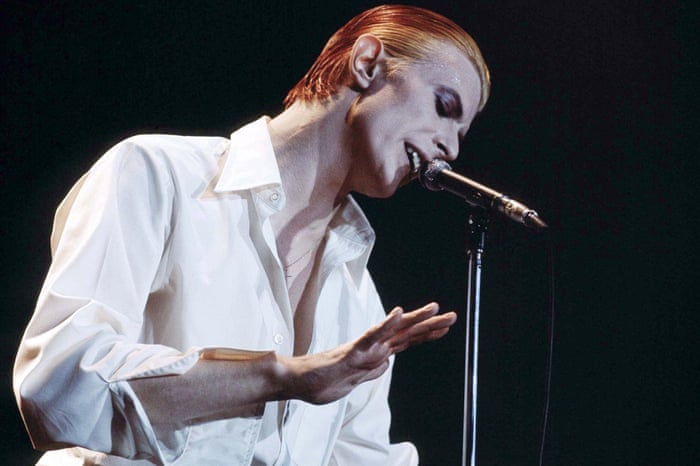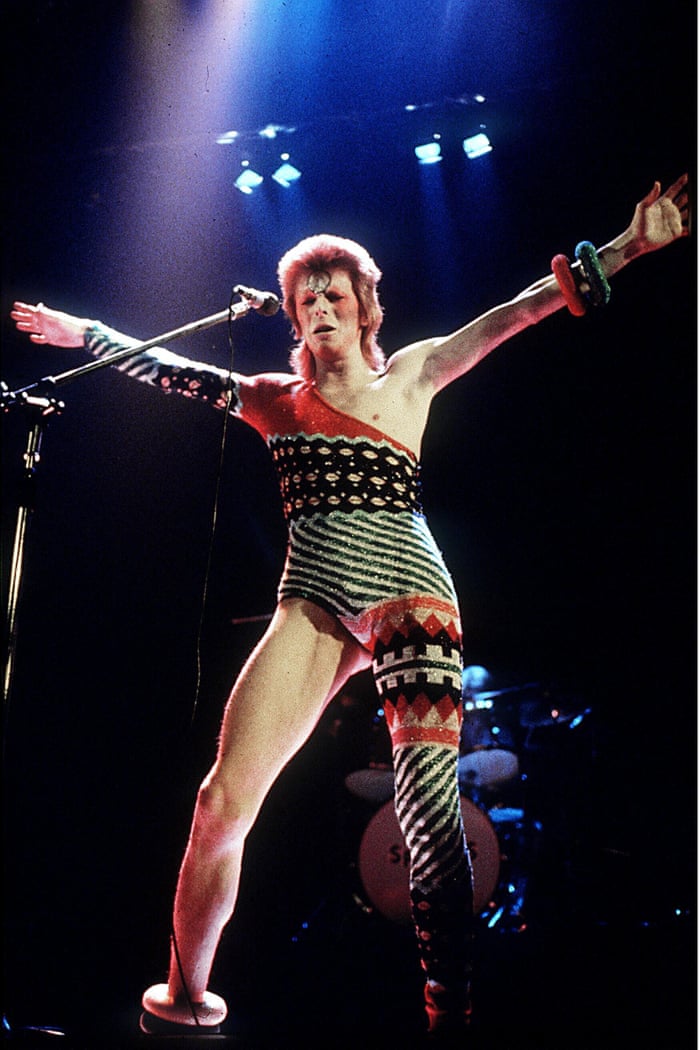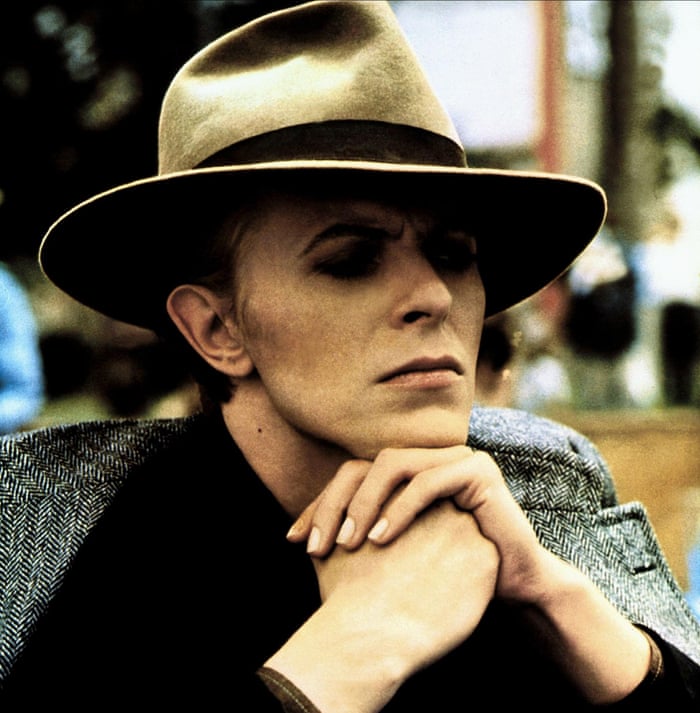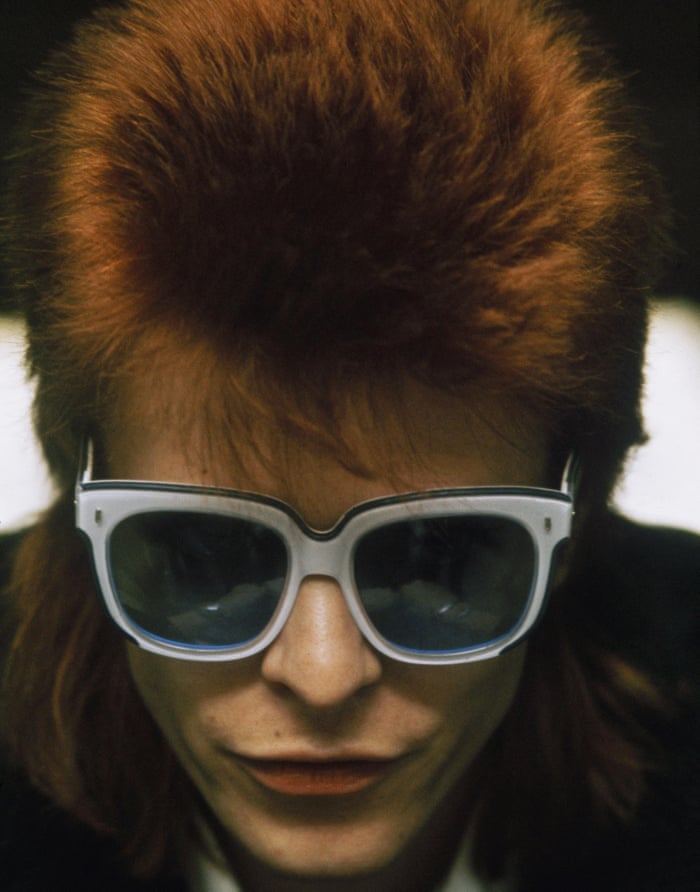 |
| David Bowie on stage as the Thin White Duke |
From Aladdin Sane’s jumpsuit to the Thin White Duke’s suits, Bowie’s
distinctive outfits have influenced designers from Jean Paul Gaultier to
Hedi Slimane
In 2012, I visited the V&A’s costume preservation department to see the preparations for the museum’s record-breaking David Bowie retrospective
the following year. A curator carefully unwrapped the tissue paper
around one garment and laid it out for me to see. It was an item as
familiar to me as the school uniform I wore for my first five years of
secondary school, and indeed, a picture of Bowie wearing it has been on
my bedroom wall for most of that time: a knitted jumpsuit in a bright zig-zag pattern, with one leg cut off at the upper thigh and one arm cut away to reveal bare shoulder. It was, of course, a stage outfit
he wore during his Ziggy Stardust/Aladdin Sane tours, and the biggest
surprise about it for me, close up, was that it was knitted, with quite
thick wool in the most richly patterned parts.
I remarked that it must have been ridiculously hot to wear during a
frenetic live show, and the curators laughed and said that sweat damage
was one of the main problems they were working on with the stage
clothes. (The original jumpsuit, for instance, had long since rotted
away, and the one shown at the V&A had actually been recreated by
its designer, Kansai Yamamoto, for an exhibition in New York a few years earlier.)
 |
| David Bowie in 1973 on his Ziggy Stardust tour wearing a Kansai Yamamoto knitted jumpsuit. |
Later, I got to talk to Yamamoto on the phone and he told me about
the first time he saw Bowie wear his clothes on stage, in a 1973 show at
the Radio City Music Hall in New York. “There’s a time difference of 13
hours between Tokyo and New York, but a good friend of mine phoned me
in Japan many times through the night, saying, ‘There’s this very
interesting person called David Bowie
here in New York. You’ve got to see him. Fly over immediately!’ If
somebody calls you again and again at 3am, it must really be pretty
interesting. So I cancelled all other plans for that week, and got on a
plane to see his show.
“My clothes were normally made for professional models – this was the first time they had been used for an artist or singer. It felt like the beginning of a new age.”
The two men became friends, and later that year met up in Tokyo to collaborate on more stage outfits, including the knitted jumpsuit. Yamamoto helped Bowie gain a deeper understanding of the Japanese culture that so fascinated him, taking him to dinner with the revered kabuki actor Bandō Tamasaburō, for instance. Through Bowie, Yamamoto says he learned to present his designs more theatrically, and start a second career as a producer. “Throughout this time, we were always bouncing off each other, inspiring each other.”
The jumpsuit, meanwhile, has echoed through fashion ever since, from the 80s designs of Bodymap to the knitted leggings every teenage girl was sporting last winter.
There are stories like this from almost every year of Bowie’s long career. He was the first, the original and the best pop chameleon, ringing the ch-ch-changes for every new release or tour, playing with costume, masks and alter egos in a way that always felt organic and interesting. He stole ideas from everywhere and was a great collaborator, pushing almost everyone he worked with to do their best work, but Bowie was always unmistakably Bowie, adding his own distinctive sense of style into the mix.
 |
| Wide-brimmed fedoras like the one Bowie wore in The Man Who Fell to Earth appeared on the Lanvin catwalk in 2011. |
“I was living in Paris when I first experienced Bowie’s music, and the influence was instant and permanent,” Jean Paul Gaultier wrote on Out magazine’s website. “He was in a dress for the sleeve of The Man Who Sold the World – there was a sense of ambiguity and originality that was incredible at the time ... I remember going to gay bars in London that Bowie was known to frequent and it gave many of us courage not to hide, to have confidence in ourselves.’
In 1975 Bowie veered off into new territory, exploring his love of Philly soul with the Young Americans album, and introducing a look that has echoed through both gay clubs and soul weekenders ever since: the extravagant quiff or dyed wedge cut, teamed with a tailored shirt and baggy trousers. A year later, with Station to Station, he created his last great character, the Thin White Duke, whose louche, suited look has influenced menswear ever since.
In 1980 he adopted a New Romantic pierrot guise for Scary Monsters (and Super Creeps), an album explicitly reclaiming ground that had been occupied by club kids who had grown up under his influence. After that he lost his way a little, but it barely mattered: he had changed popular culture indelibly.
There was no internet when I was in my teens. For us, a new Bowie album was not just a collection of songs, it was a doorway to new images, books, art, cultural references and sounds. We pored over his interviews and influences, and made them our own. Although I never did get the chiselled cheekbones I so longed for, through Bowie I learned about Linsday Kemp and Aleister Crowley, about Iggy Pop and Nietzsche, about Kraftwerk and kabuki, and all kinds of other things besides.
I’m not alone in this, of course. Which is why Bowie has been so influential across our culture, and nowhere more so than fashion. Bowie’s 1980 track Fashion has provided the soundtrack for more catwalk shows than I could ever hope to list here, and of course Bowie made a cameo appearance – judging a walk-off between two competing male models – in Ben Stiller’s brilliant 2001 fashion spoof Zoolander. In 2014, he even appeared in a fashion ad himself, crooning seductively to the model Arizona Muse for Louis Vuitton. (“He was so lovely,” Muse told me afterwards. “Very charming, and easy to talk to, with a really nice, calm energy.”)
Lady Gaga makes explicit reference to Bowie in both her Applause and Just Dance videos, while Kate Moss – that most reliable barometer of all that is best in British style – has dressed as Bowie twice: for British Vogue in 2003, and for French Vogue in 2011. In 2014, she did it again, picking up a Brit award on Bowie’s behalf dressed in one of Yamamoto’s actual Ziggy Stardust costumes.
But this is mere surface, and Bowie’s influence is deep in the DNA of contemporary fashion.
To celebrate his 69th birthday – sadly only four days ago – several fashion websites pointed to his influence on recent catwalk shows, for both men’s and women’s collections. Givenchy’s spring 2010 ready-to-wear show, for instance, featured a striped blazer that is a clear homage to a Freddie Burretti one sported by Bowie in 1973; a year later, Lanvin’s autumn 2011 show saw models dressed in wide-brimmed fedoras like Bowie in The Man Who Fell to Earth. Balmain’s collection had an Aladdin Sane jumpsuit, while Walter Van Beirendonck had a blazer adorned with a clever Aladdin Sane diagonal flash across the lapels, and Dries Van Noten and Alber Elbaz’s autumn menswear shows both heavily referenced the Thin White Duke.
In 2012 Emilio Pucci had jewel-bright suits with more than a hint of Bowie about them, while Alexander McQueen had wide trousers straight from Bowie’s Hunky Dory period. Jean Paul Gaultier, who used Diamond Dogs to open his first show for Pierre Cardin in 1975, has returned to this fertile creative ground again and again, paying homage to Kansai Yamamoto’s colourful prints in spring 2011, and revisiting the one-legged jumpsuit in 2013, both times lovingly acknowledging the reference by sending out his models in flaming red mullets.
Hedi Slimane – another huge fan who claimed, in 2010, “I was literally born with a David Bowie album in my hand” – last referenced the Thin White Duke in his spring 14 collection for Saint Laurent. A year later, Raf Simons made a nod to Yamamoto’s jumpsuits in his spring 2015 couture collection for Dior, while Jun Takahashi recreated the cover of Heroes for his Undercover Fall 15 menswear lookbook.
 |
| ean Paul Gaultier acknowledged Bowie’s inspiration |
Speaking at the launch party for the V&A exhibition, Tilda Swinton admitted it was the image, not the music, that first drew her into Bowie’s world. “When I was 12 … I carried a copy of Aladdin Sane around with me – a full two years before I had the wherewithal to play it,” she said.
“The image of that gingery, bony, pinky-whitey person on the cover with the liquid mercury collar bone was – for one particular young moonage daydreamer – the image of planetary kin, of a close imaginary cousin and companion of choice.
“I’m not saying that if you hadn’t pitched up I would have worn a pie-crust collar and pearls like some of those I went to school with. I’m not saying that if you hadn’t weighed in, [the London DJ and club icon] Princess Julia would have been less inventive with the pink blusher. Simply that you provided the sideways like us with such rare and out-there company, such fellowship; you pulled us in and left your arm dangling over our necks, and kept us warm.”
More : http://www.theguardian.com



0 comments:
Post a Comment